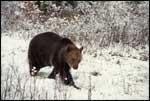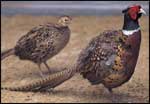Animal Speeds
Man always has been very conscious of speed and through the years has invented faster and faster machines to take him from one place to another. In a car or plane, he can cover great distances in a hurry, but on his own two feet man cannot compete with the speed of many fellow creatures.

With this awareness of speed, it is not surprising that man would want to know just how fast other animals can run or fly. However, measuring animal speeds accurately is very difficult, and the results can vary. Car speedometers, plane airspeed indicators, radar devices, and stopwatches have been used to obtain some information, but speeds vary with individual animals and conditions. Fear is another factor that can influence the animal’s top speed. An animal trying to escape may surpass its normal top speed by quite a bit, just as a runner can turn on a short, extremely fast, burst of speed to win a race. However, this escape speed cannot be maintained for any great distance. Predatory species also may turn on a burst of speed to catch their prey.
There probably have been more arguments over the maximum speeds of birds than any other creatures. Estimated speeds for some species rate higher than 200 miles per hour, but most authorities believe some of these records, which were established several years ago, are a bit exaggerated. Many disagreements are based on the fact that the speed of a bird in flight often is measured as ground speed. This ground speed is determined by measuring the time required to fly from one fixed point on the ground to another. Since no consideration is given to the wind conditions in such a measurement, the results can be misleading. A bird flying at an airspeed of 25 MPH with a 35-MPH tail wind will appear to be flying at a ground speed of 60 MPH. If no wind were present, the bird would cover the same distance at only 25 MPH, and flying against a head wind would further reduce the speed. Measurements made with airplanes and radar devices have established flight speeds at lower, but possibly more accurate levels.

One of the slowest recorded speeds for a bird in flight is the 5 MPH credited to the woodcock. Fastest speeds are recorded for the swifts, falcons, and homing pigeons, depending upon which statistics are accepted. Two species of swifts, timed over a measured course of two miles in India, covered the distance in thirty-six to forty-two seconds. This places their speeds at 171 to 200 MPH. Since no data are recorded concerning the wind speed or direction at the time of the flight, their true airspeed could have been less. It is reported that on another occasion a flock of swifts overtook and circled a small plane traveling at 68 MPH. It is estimated that these birds were flying at 100 MPH.
Other authorities consider the homing pigeon to be the fastest bird because it can maintain a high rate of speed for long distances. It has been accurately measured at a speed of 94.3 MPH. One homing pigeon averaged 73 MPH over a distance of 182 miles, and several have flown over 90 MPH for distances of at least 80 miles.
The peregrine falcon, which preys on other birds, flies at speeds of 65 to 70 MPH, but it has been clocked at diving speeds of 170 to 180 MPH. Most ducks and geese can fly at a speed ranging from 60 to 70 MPH; however, their usual flying speed is much slower. At its 40-MPH cruising speed, the mallard out flies the teal, which cruises along at 32 MPH. But if pressed, both birds can accelerate to around 60 MPH.

Probably the most amazing speed, because of the bird’s small size, is that recorded for the hummingbird. With wingbeats approaching 200 per second, the ruby-throated hummingbird can dart from flower to flower at speeds up to 60 MPH.
Although the speediest of land animals cannot match the times of the fastest flyers, the cheetah, recognized as the world’s fastest runner, is able to run 70 MPH for short distances. From a standing start, the cheetah can accelerate to 45 MPH in two seconds and cover a distance of sixty-five yards. Because of its limited endurance, this big cat is exhausted after a high-speed dash of several hundred yards, but it can run comfortably at 30 to 40 MPH for as long as half an hour.

Pronghorn antelope are the fastest mammals on the North American continent. When chased by a car, one pronghorn maintained a speed of 60 MPH for two miles before it dropped to 50 MPH and then slacked of to a running speed of 40 MPH. In many instances these fleet-footed animals have averaged 35 MPH for distances as great as twenty-seven miles.
In a half-mile distance, a jackrabbit can run 45 MPH. The slower coyote, which runs between 35 MPH and 40 MPH, cannot catch it in this first half-mile, but the coyote has the endurance to maintain its speed over a greater distance until its faster prey gets tired and slows down. An elephant usually strolls along at a comfortable 2 to 4 MPH, but when charging, an African elephant can reach a speed of 25 MPH.
Man appears on the speed chart at 20 to 25 MPH. Some of our fastest runners have managed the 100-yard dash in 9.1 seconds, which converts to a speed of 22.48 MPH. When Bob Hayes first set this record in 1963, he attained his top speed between the 60- and 75-yard marks. During this 15-yard stretch, which he covered in 1.1 seconds, he was running at 27.89 MPH. But just as the cheetah cannot maintain its maximum speed for long, neither can man. The speed for most serious long-distance runners usually averages about 12 MPH.
In comparisons with the world’s fastest animals, man is pretty far down the scale, but there are still many creatures that move a lot slower. The snail can manage only fifty-five yards an hour. In that fabled race of storybooks, man may not be able to match the speed of the hare, but he’s way ahead of the turtle that plods along at one-tenth of a mile per hour.
| Animal | Possible Speeds in Miles Per Hour |
|---|---|
| Swift (some species) | 100 to 200 |
| Homing pigeon | 90 to 95 |
| Falcon | 65 to 70 |
| Cheetah | 65 to 70 |
| Ducks and geese | 60 to 70 |
| Pronghorn antelope | 55 to 60 |
| Mourning dove | 55 to 60 |
| Hummingbird | 55 to 60 |
| Horse | 45 to 50 |
| Starling | 45 to 50 |
| Ostrich | 45 to 50 |
| Jackrabbit | 40 to 45 |
| Elk | 40 to 45 |
| Quail | 40 to 45 |
| Crow | 40 to 45 |
| Gray fox | 35 to 42 |
| Coyote | 35 to 40 |
| Deer | 35 to 40 |
| Heron | 35 to 40 |
| Sparrow | 35 to 40 |
| Pheasant | 35 to 40 |
| Moose | 35 to 40 |
| Gull | 30 to 35 |
| Bison | 30 to 35 |
| Grizzly bear | 30 to 35 |
| Pelican | 25 to 30 |
| Blue jay | 20 to 25 |
| Man | 20 to 25 |
| Elephant | 4 to 25 |
| Bat | 12 to 15 |
| Squirrel | 10 to 12 |
Ilo
Hiller
1983 Animal Speeds.
Young
Naturalist. The
Louise Lindsey Merrick
Texas Environment Series,
No. 6, pp. 32-35. Texas
A&M University Press,
College Station.